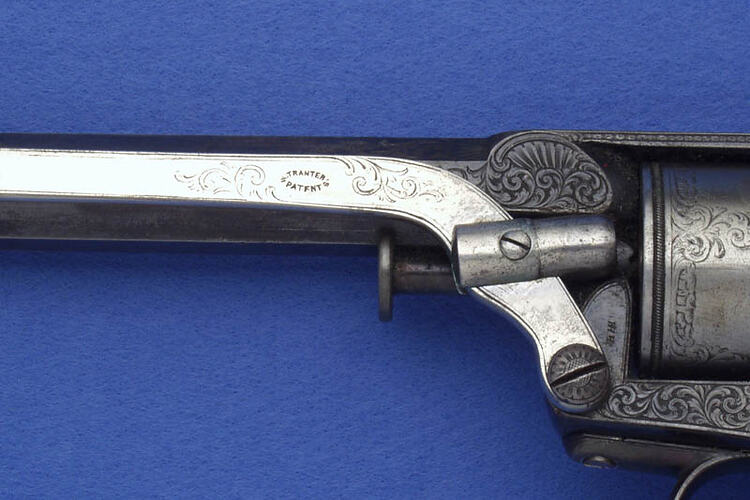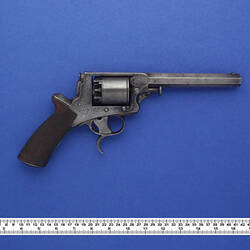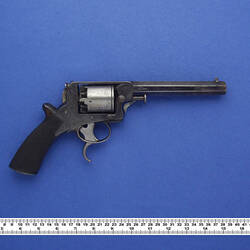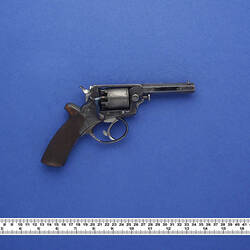William Tranter was born in 1816 at Oldbury near Birmingham and was the eldest son of Thomas and Mary Tranter. Thomas' occupation was blacksmithing. William had four brothers and four sisters and in 1830 at the age of 14 was apprenticed to the gunsmithing firm of Hollis Bros & Co. in Birmingham. He left Hollis Bros in 1839 and bought out the business of Robert Dugard at 29.5 Whittall Street, Birmingham with a small legacy left to him by an uncle.
An advertisement in 1841 read: "William Tranter (successor to R. Dugard), Gun and Pistol maker, for home and exportation, No.29.5 Whittall Street, Birmingham. Percussion caps, waddings, implements, barrels, locks, and furniture of every description." He stayed at the Whittall St address until 1849. In 1846 he took on his younger brother David as an apprentice.
He was also in partnership with John and Isaac Hollis in Hollis Brothers and Co. at 10-11 Weaman Row between 1844 and 1849, and also with Isaac Brentnall Sheath from 1845. Tranter had shops, sheds and steam machinery, yard and premises at 50 Loveday Street between 1854 and 1860. By 1851, Tranter's factory was at 13 St Mary's Row in the heart of Birmingham's Gun Quarter.
Up until, and possibly after, 1853 he manufactured over 8000 1851 Adams revolvers under license. In about 1853 he started making the first of his double trigger, double action revolvers. This model was built on the Adams frame and had a detachable rammer which fitted onto a peg attached to the frame. In about 1854 production began on a new model, the rammer being secured by a keyed peg on the frame and a hook on the barrel. This rammer could still be removed by turning it around to the appropriate position. He also manufactured his own version of the Beaumont Adams revolver, known as the Tranter/Adams/Kerr.
Some time after 1856 production began on what is now commonly referred to as the third model double trigger revolver. This had a more streamlined frame and the rammer was secured to the frame with a screw. At the same time production began on a single trigger double action revolver based on the same frame, now referred to as the fourth model. The production of percussion revolvers continued well after the introduction of the cartridge revolver as many customers preferred the old system thinking this new fangled cartridge system would not last. Tranter also produced percussion revolving rifles in various configurations, including both single and double trigger mechanisms.
In America both single and double trigger percussion revolvers were popular in the Confederate States. A. B. Griswold & Co and Messrs Hyde & Goodrich, both from New Orleans, were importers. Allan Pinkerton, the Scottish born founder of the most famous detective agency in America, carried two Tranters and is said to have armed his men with Tranter double trigger revolvers. A nickel plated and engraved model 1879 Tranter made by Thomas Tranter after William retired in 1885 and marked "Made for W.A. Pinkerton by Thos M. Tranter. 16 Weaman St., Birmingham." is thought to have belonged to Wm. A. Pinkerton, one of Allan's sons.
During this period it was normal practice to describe the diameter of the bore in bore size rather than calibre, the bore size being the number of round lead balls of that diameter needed to weigh one pound. The most common ones used by Tranter were 120 bore (.320"), 80 bore (.380"), 54 bore (.442"), 38 bore (.500") and 24 bore (.577").
In 1863 Tranter secured patents for some of the first rim fire revolvers in Britain. Revolvers based on these patents included small calibre single and double action revolvers as well as the model 1863, a large solid frame revolver in .442" calibre. This revolver was fitted with a powerful lever extractor which acted on the rim of the spent cartridge, this proved more effective as the cartridges of the time were prone to jamming in the chamber and a normal extractor could break the base of the cartridge away, leaving the rest still in the chamber.
He also completed construction of a new factory in late 1867 at 31 Lichfield Road, Aston Cross, which spread over an area of about four acres. Facing the road, there was a three story blue brick warehouse which measured 90 feet by 29 feet. Behind this were the filing shops arranged in a collection of buildings 110 feet long and three stories high. At the rear was the main factory This building was one open room measuring 240 feet long by 81 feet wide, with a height of about 40 feet. The engine house contained a large horizontal engine which powered the whole factory. The introduction of steam machinery to such a great extent by a private gunmaker was a first for the Birmingham gun trade. The factory at Aston Cross was called "The Tranter Gun and Pistol Factory" and business was conducted at both addresses for some time.
During this time it was the most extensive pistol making business in the Midlands, producing over 20 different cartridge revolvers and pistols of Tranter's own design. He also had government contracts for Snider rifles, and supplied weapons of every kind to the gun trade in general, including overseas markets. His own patented mechanisms would have had preference, but he made special production runs under the patents of firms or individuals lacking manufacturing facilities of their own. In 1877 the Lancers reputedly carried out trials on Tranter double barrel pistols.
Tranter was a substantial property owner, a founder/shareholder in the Birmingham Small Arms Co. Ltd. (a director in its early years) and a prominent member of the Birmingham small arms trade. In 1854 he was called as a witness before the parliamentary committee on small arms. The Braendlin Armoury, the firm of Bently and Playfair, and Charles Reeves were all tenants of William Tranter.
In 1868 he began manufacturing a revolver to take the .450 boxer cartridge, and in 1878 was granted a government contract for a solid frame .450 centre fire revolver to be used by the British army. He also made single action single shot saloon pistols and rook rifles in various calibres. One of the last weapons he made was an excellent hinged frame, self extracting revolver called the model 1879.
Tranter was very patent-conscious, and between 1849 and 1888 lodged 24 patent applications. The 19 patents for cartridge weapons included bolt action rifles and machine guns as well as his revolvers.
When Tranter retired in 1885, he gave each of his four nephews a gilt and engraved double action revolver as a keepsake. The factory was leased by George Kynoch, a friend of William Tranter, and it was renamed The Kynoch Gun Factory and in 1888 the Aston Arms Factory. By 1900 business had ceased and the factory was occupied by the Clipper Automatic Tyre Co., and then by Dunlop Rubber, making motor vehicle tyres. The factory was ultimately demolished in 1961.
William Tranter died on January 7th, 1890.
More Information
-
Keywords
-
Localities
-
Authors
-
Article types



